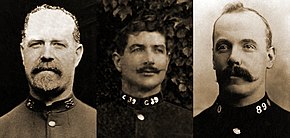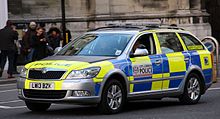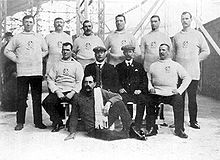The City of London Police is the territorial police force responsible for law enforcement within the City of London, including the Middle and Inner Temples. The force responsible for law enforcement within the remainder of the London region, outside the City, is the much larger Metropolitan Police Service, a separate organisation. The City of London, which is now primarily a financial business district with a small resident population but a large commuting workforce, is the historic core of London, and has an administrative history distinct from that of the rest of the metropolis, of which its separate police force is one manifestation.
The City of London area has a resident population of around 9,400, however there is also a daily influx of approximately 483,000 commuters into the City, along with thousands of tourists.
The police authority is the Common Council of the City, and unlike other territorial forces in England and Wales there is not a police and crime commissioner replacing that police authority by way of the Police Reform and Social Responsibility Act 2011, but like a police and crime commissioner, the Common Council is elected.
As of 2019, the force had a workforce of 1,207 including 756 full-time police officers and 451 support staff. The force is also supported by much smaller numbers of special constables, police community support officers, and designated officers. The headquarters is located at the Guildhall and there are two additional stations at Bishopsgate and Wood Street. The City of London Police is the smallest territorial police force in England and Wales, both in terms of geographic area and head-count. The current commissioner (equivalent to the chief constable in other forces) since January 2016 is Ian Dyson, who was formerly the force’s Assistant Commissioner.
History
Traditionally the responsibility for policing in the City had been divided between day and night City Watch, primarily under the two sheriffs. Their responsibilities were shared with the aldermen’s officers – the ward beadles – who are now purely ceremonial. It was these officers’ responsibility for ensuring that the Night Watch was maintained. Policing during the day eventually came under the City Patrol, which evolved into the City Day Police, which was modelled on the Metropolitan Police. The London City Police was officially formed in 1832, before becoming the City of London Police with the passing of the City of London Police Act 1839, which gave statutory approval to the force as an independent police body and headed off attempts made to merge it with the Metropolitan Police.
In 1840, the City of London Police moved its headquarters from the Corporation’s Guildhall to 26 Old Jewry, where it remained until it was relocated to Wood Street in 2001. The force’s current headquarters is at the Guildhall. Former stations include Moor Lane (destroyed in the Blitz on 29 December 1940) and Cloak Lane (closed 1965).
Some notable events the force has been involved with include the Jack the Ripper murders, the 1910 Houndsditch murders, and the response to the IRA’s bombing campaign during the years of the Troubles. The early 1990s saw the IRA carry out a number of high profile attacks in the City, such as the 1992 Baltic Exchange bombing and the 1993 Bishopsgate bombing, resulting in huge economic and infrastructural damage. As a result the Traffic and Environmental Zone, better known as the “ring of steel”, was officially established in 1993 by Owen Kelly, the then City of London Police commissioner. Some aspects of the ring of steel were ‘stepped down’ in the late 1990s following the cessation of IRA hostilities but stepped up again after the September 11 terrorist attacks.
List of commissioners

Assistant Commissioner in ceremonial full-dress uniform for the Lord Mayor’s Show.
- Daniel Whittle Harvey (1839–1863)
- Colonel Sir James Fraser (1863–1890)
- Lieutenant-Colonel Sir Henry Smith (1890–1902)
- Captain Sir William Nott-Bower (1902–1925)
- Lieutenant-Colonel Sir Hugh Turnbull (1925–1950)
- Colonel Sir Arthur Young (1950–1971)
- James Page (1971–1977)
- Peter Marshall (1977–1985)
- Owen Kelly (1985–1994)
- William Taylor (1994–1998)
- Perry Nove (1998–2002)
- James Hart (2002–2006)
- Mike Bowron (2006–2011)
- Adrian Leppard (2011–2015)
- Ian Dyson (2016–present)
Officers killed in the line of duty

Sergeants Tucker and Bentley and Constable Choate, murdered while on duty on 16 December 1910
Leadership structure
- Commissioner – Ian Dyson
- Assistant commissioner – Alistair Sutherland
- Commander – Jayne Gyford (Operations & Security)
- Commander – Karen Baxter (National Coordinator for Economic Crime)
- Chief superintendent – David Lawes (Uniformed Policing Directorate)
- Temporary detective chief superintendent – David Evans (Intelligence and Information Directorate)
- Temporary detective chief superintendent – Glenn Maleary (Economic Crime Directorate)
- Temporary detective chief superintendent – Peter O’Doherty (Crime Investigation Directorate)
Uniform
Whereas the majority of British police forces have white metal badges and buttons, those of the City Police are brass. The force also have red and white chequered sleeve and cap bands (red and white being the colours of the City of London), which in most other British police forces are black and white. Female officers wear a red and white cravat.
Their helmet has altered little since its introduction in 1865 and has a crest instead of the white metal boss worn on the Metropolitan Police helmet. The “helmet plate” or badge is the City of London coat of arms; this is unusual for a police force in England and Wales in that it does not include the St Edward’s Crown, neither does it have the Brunswick Star, which is used on most other police helmets in England and Wales.
On state and ceremonial occasions, the commissioner and his deputy wear a special court dress uniform with a gold aiguillette and a cocked hat adorned with white swan’s feathers; other than on these occasions, they wear standard uniform.
Equipment and vehicles

A City of London Police car pictured in 2014
City of London police carry warrant cards. Like other British police forces, City of London police officers are not routinely armed, but some officers have received firearms training and are authorised firearms officers. City of London police equipment includes PAVA irritant spray, batons, and handcuffs. Many officers are also equipped with the Taser electroshock weapon; according to the police force’s reported figures, Tasers have been deployed (including drawing or “red-dotting”) about seven times per month. In the September 2018 to September 2020 period, the City of London Police recorded 11 incidents of police officers firing Tasers on suspects.
The City of London Police maintains a fleet of police vehicles, including SUVs, compact cars, motorcycle, and vans, as well as one horsebox. All of the force’s response vehicles, including armed response vehicles (ARVs) carry a defibrillator and first aid supplies, for use in the event of an emergency.
Mounted unit

Mounted Section officers
The City of London Police maintains a mounted police unit. In addition to regular duties, the horses of the mounted unit has been used to trample wildflower seeds at the Barbican Wildlife Garden at the request of the community wildlife gardeners. The horses’ ceremonial duties include participation in Trooping the Colour and the Lord Mayor’s Show; the City of London Police mounted unit also escorted the exhumed remains of King Richard III through the city of Leicester from St Nicholas Church to Leicester Cathedral, en route to their reburial.
Ranks
The ranks from constable to chief superintendent are the same as all other British police forces. The three senior ranks are similar to those used by the Metropolitan Police. Constables and sergeants display collar numbers on their rank badges (in the range 1 to 150 for sergeants and 151 to 999 for constables). Officers between the ranks of inspector and chief superintendent (who do not have collar numbers) display their warrant numbers instead.
Insignia
| City of London Police ranks | |||||||||
|---|---|---|---|---|---|---|---|---|---|
| Rank | Commissioner | Assistant commissioner | Commander | Chief superintendent | Superintendent | Chief inspector | Inspector | Sergeant | Constable |
| Insignia |  |
 |
 |
 |
 |
 |
 |
 |
 |
| Note |
|
||||||||
The City of London police also has a special constabulary with seven ranks of officers. In law, there is no equivalence to regular police ranks. The Police Act 1996 only defines the office of “special constable” with no rank or grading system defined in statute.
Workforce
The following is the current released workforce data for the ranks. The chief officers rank covers all senior ranks as well as special constables covering all special constable ranks.
| City of London Police Workforce | ||||||||||||
|---|---|---|---|---|---|---|---|---|---|---|---|---|
| Rank | Police staff | Police support volunteer | Designated Officer | PCSO | Special constable | Constable | Sergeant | Inspector | Chief inspector | Superintendent | Chief superintendent | Chief officer |
| Female personnel | 263 | 3 | 0 | 1 | 18 | 129 | 26 | 9 | 7 | 3 | 1 | 2 |
| Male personnel | 177 | 8 | 0 | 5 | 57 | 413 | 94 | 32 | 14 | 12 | 4 | 2 |
| Total personnel | 440 | 11 | 0 | 6 | 75 | 542 | 120 | 41 | 21 | 15 | 5 | 4 |
| Reference | 2019 Police workforce open data tables | |||||||||||
Special Constabulary
History
The City of London Police have had special constables since at least 1911, when 1,648 were called for duty during docks strikes. There was one day in 1918, when the only warranted officer within the city of London was a special constable
Current status
|
|
This section needs additional citations for verification. (May 2021)
|
It consists of 62 special constables, the majority of whom are attached to the Uniformed Policing Directorate (led by a special superintendent, who forms part of that directorate’s management team, assisted by a special chief inspector and a number of special inspectors and special sergeants), and undertake duties during evenings and nights in support of the regular force in dealing with issues arising from the busy night-time economy of the City. However, other officers perform more specialist roles in the force’s other directorates, including fraud investigation in the Economic Crime Directorate and control room operation in the Intelligence and Information Directorate. Many officers have specialist training and perform duties as response drivers, “Level 2” public order officers and cycle officers.
As in all forces, special constables are expected to commit to a minimum of 200 hours’ duty each year, and in return receive out-of-pocket expenses and free travel on the Transport for London network. They receive no pay.
Officers switched to regular rank titles in 2006 (having previously used distinct titles such as “section officer” and “divisional officer”), and to regular rank insignia in 2013. The CLSC is led by the chief officer (in 2019 Special Commander James Phipson), three special superintendents, two special chief inspectors, one special detective chief inspector, five special inspectors, a number of special sergeants and a special detective sergeant. The previous chief officer, Special Commander Ian Miller, remains a warranted officer but on secondment to the College of Policing. The position of deputy chief officer carries the rank of special chief superintendent, but is currently vacant.[citation needed]
Uniform and equipment is identical to that of regular (full-time) police officers. Officers of the Honourable Artillery Company Detachment of Special Constabulary (which forms part of the CLSC) wear the title “HAC” when in formal uniform.[30] Special Constables have four-digit collar numbers beginning 11 or 12, and Special Sergeants have four-digit collar numbers beginning 10.
The CLSC were awarded the Ferrers Trophy in 2006 for the efforts of their officers after the 7 July 2005 London bombings. The award is given annually to police volunteers, for exceptional dedication and innovation. It was the first time in the award’s history that an entire special constabulary received the trophy.
Honourable Artillery Company Detachment
In 1919, following a decision to increase the strength of the Metropolitan Police Reserve Force, the Home Secretary approached the Honourable Artillery Company to form a division of special constabulary. Some 150 members, mostly great war veterans, rallied to the call and joined the division, forming the HAC Detachment. At the outbreak of the second world war, the detachment was integrated into G Division of the Metropolitan Police and then later with Islington Division. Following reorganisation, the detachment is now part of the City of London Police Special Constabulary, its administrative base is Armoury House.
In 2010, the Ferrers Trophy was awarded to Special Constable Patrick Rarden of the detachment for using his banking skills and experience to help train colleagues and provide invaluable assistance to solve fraud cases.
Olympics

The gold-medal-winning City of London Police team at the 1908 Summer Olympics.
Teams of the City of London Police have participated in the Olympic games three times in the tug of war tournament. At the 1908 Summer Olympics they won the gold medal, beating a team of the Liverpool Police in the final. In 1912 the team was beaten in the final by one of the Stockholm Police. At the 1920 Summer Olympics the team regained its title, beating the Netherlands. This was the last time tug of war was an Olympic sport, which means the City of London Police is still the reigning Olympic champion.
Museum
The City of London Police Museum is dedicated to the police force and its story of policing.Exhibits include uniforms, Victorian-era police equipment and artefacts, communication devices, World War II displays, and exhibits about Jack the Ripper and other famous murder cases.
The museum relocated in November 2016 to the space formerly used by the Clockmakers’ Museum, next to the Guildhall Library. The new museum was funded by a Heritage Lottery Fund grant.
Other corporation policing bodies
The Corporation of London, the local authority for the city, also operates further limited policing bodies. These bodies are not part of the City of London Police:
- City of London market constabularies
- Hampstead Heath Constabulary,
- Epping Forest Keepers
